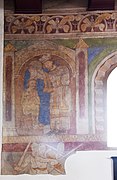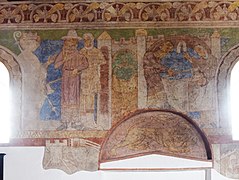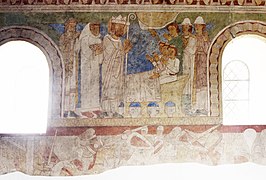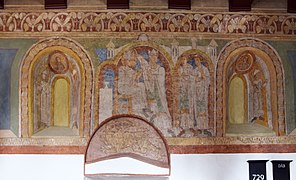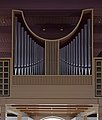Eel Kirke
Aal Kirke (until 2010 Ål Kirke) is a church belonging to the Danish national church in the diocese of Ribe in Oksbøl in the parish of Aal Sogn .
Buildings and history
The church was built in several stages, with the nave being the oldest part. Archaeological research has dated this section to the end of the 10th century. The church was later expanded three times. The choir was built in the east, a sacristy on the north side and around 1200 a church porch in the south. Male church visitors used to enter the building via the latter, while the now walled-up women's entrance was in the north. There used to be a vestibule in front of this too.
The lower part of the church walls is made of granite blocks, while the upper part is made of tuff . These stones come from the area around Andernach and came to Denmark by ship. In the 14th century the nave was extended to the west and the church received a tower, about a third higher than today and with a flat roof. Since the tower suffered damage from subsidence and frost , it was reduced in size in 1767. The top of the tower is crowned by a heron, which is supposed to watch over the villages of the parish. In 1908 today's main entrance was built in the tower.
There are some special features on the outside walls of the church. Three very old crosses are carved into the granite ashlars of the vestibule to the south, the first on the side with the door, the other two in the stones on the east side. An upside-down runic inscription on the south side of the choir means "Blomae", a man's name, possibly from the stonemason.
The roof is covered with lead, a decorated lead plate on the vestibule with the inscription "KB 1978" indicates that work was carried out this year.
Church interior
Choir
altar
The altar is made of granite and was previously provided with painted wood paneling. A three-winged cabinet altarpiece from around 1450 used to stand on the altar. It was dismantled in 1886 because of its poor state of preservation and is now in the Danish National Museum . The altar decoration from 2000 was made by Erik Heide , a sculptor from Øster Jølby . It shows the entry of Jesus into Jerusalem on Palm Sunday.
Window behind the altar
The east wall of the choir has three windows. The colored glass mosaic entitled "A Hymn to Easter", consecrated at Easter in 1971, was made by the painter Urup Jensen . The glass used for this was originally made for Marc Chagall , who in 1962 created the windows for the synagogue at Hadassah University Hospital in Jerusalem . Jensen used remnants of this glass that Chagall did not need.
Wooden reliefs
In the central choir wing, 14 wooden reliefs made around 1450 hang on the north wall. They were carved by Hans Snitger the Elder from Lüneburg and were originally attached to the cabinet altar piece.
The cycle follows the traditional pictorial program of the life of Mary . In the figurative group of the Visitation of the Virgin Mary a head was lost and was later added by a carver in a clearly different style; it was Elisabet a man's face with a beard.
crucifix
The crucifix on the north wall of the choir was created by the artist Skjold – Lund. The model was a triumphal cross that was set up earlier in the church. This older cross was made between 1200 and 1225. Only the figure of Christ that is now in the Danish National Museum has survived. The old cross had square end plates with the symbols of the evangelists .
Baptismal font
In the middle of the choir is a simple, barrel-shaped baptismal font made of granite. Due to color pigments on the outside, it is believed that it was painted earlier. It is one of the oldest baptismal fonts in this part of Denmark.
Heraldic shields on the choir vault
Four coats of arms are painted on the vault in the choir. These are the ancestors of the Lords of Hesselmed . The coat of arms on the far left belongs to the Juel family . The year 1558 indicates the burial of the remains of Jens Juel, who died in 1553. The coat of arms on the far right belongs to the Rosenkrantz family .
Main nave
Frescoes
The Romanesque frescoes in the nave, which were created around 1200–1225, differ greatly in theme. In the upper area of the north and south side scenes from the life of Nikolaus von Myra are shown; below the red border there are equestrian fights.
North face
A scene on the far left shows Nicholas baptizing. To the right of this is a representation of the legend of the three scholars who were murdered by an innkeeper. In Tympanonfeld over the previous door to the woman porch you can see a lion. Further to the right, it is Nicholas who brings the scholars back to life. In the next picture you can see Nikolaus giving a bedridden man a wallet. It is Nicholas' dowry donation that enables the old man to marry off his three daughters and not have to turn them into prostitutes . The last picture shows King David with a psalter and a stringed instrument.
On the lower side of the wall, soldiers armed with swords and shields can be seen on the left. To the right of this is a post with a flag near a tower. In the further course a king is shown with a soldier in a house and further to the right a battle of mounted soldiers.
King David with psalter and instrument
South wall
Two scenes can be seen above the pulpit. On the left there are three men looking towards a holy person standing on their left. On the right there is a saint holding his hand over a person who can be recognized by the death shirt.
Above the door to the former men's vestibule you can see Nicholas being consecrated bishop. The incumbent bishop anoints him and puts the bishop's cap on his head. As on the north side, there is a lion in the tympanum field.
East wall with passage to the choir
At the top left are four people who were admitted to paradise. The Virgin Mary is said to be depicted below in the niche, and to the right of her the Archangel Gabriel . On the right, four naked people in purgatory ask to be admitted to paradise. A matching picture in the niche below has not been preserved. In the place of today's passage to the choir originally hung a triumphal cross.
Rulers
To the east of the nave there are benches on both sides. Her cheeks bear the carved initials and coats of arms of E (Elsebe) S (Skave) 1580 and F (Vicent) I (Juel) 1580. These places were reserved for the owners of the Hesselmed manor for centuries.
pulpit
The pulpit was made by Jens Olufsen from Varde and placed in the church in 1637. In the fields there are shown Moses with the two tablets of the law, the four evangelists and the blessing Jesus carrying an apple . Originally the pulpit had a sound cover . Only a small part of it with the inscription "H (er) / Peder Cl / avsøn / Sogne / prest / 1637" on a bench in the choir has survived.
organ
The organ pulpit in the west of the church dates from around 1918. At that time there was an organ bought second-hand in 1905 and assembled by I. Starup & Søn. In 1961 Frobenius Orgelbau built the current organ for the church. It has 13 stops on two manuals and a pedal . The organ, built as Opus 527, has slide chests with a mechanical action . Before installation, the organ pulpit was also rebuilt and renewed. In 2000 the organ was overhauled by the builder's workshop.
literature
- Eel Kirke. Oksbøl, 2012 (brochure available in the church).
Web links
- Parish website (Danish)
- Gert Ravn: Eel Kirke. (pdf, 3 MB) June 27, 2012 (Danish, English, German).
-
National Museum Copenhagen (Ed.): Ål Kirke: Vester Horne Herred Ribe Amt. (pdf, 9.2 MB) In: Danmarks Kirker, Volume 19.2. Copenhagen, 1984, pp. 1293-1348 (Danish).
- see : National Museum Copenhagen (ed.): Tilføjelser og Rettelser. (pdf, 4.3 MB) In: Danmarks Kirker, Volume 19.5. Copenhagen, 2003, pp. 3525–3548, here p. 3535 (Danish, additions and corrections).
Individual evidence
- ↑ Aal Kirke , p. 11.
- ↑ a b c Aal Kirke , p. 14.
- ↑ National Museum Copenhagen (ed.): Ål Kirke. (pdf, 9.2 MB) pp. 1321–1326 , accessed on October 11, 2019 (Danish).
- ↑ National Museum Copenhagen (ed.): Ål Kirke. (pdf, 9.2 MB) pp. 1330–1333 , accessed on October 11, 2019 (Danish, with photos of the old crucifix).
- ↑ National Museum Copenhagen (ed.): Ål Kirke. (pdf, 9.2 MB) pp. 1328–1329 , accessed on October 11, 2019 (Danish).
- ↑ Aal Kirke , p. 13.
- ↑ National Museum Copenhagen (ed.): Ål Kirke. (pdf, 9.2 MB) p. 1316 , accessed on October 11, 2019 (Danish).
- ↑ National Museum Copenhagen (ed.): Ål Kirke. (pdf, 9.2 MB) pp. 1336–1337 , accessed on October 11, 2019 (Danish).
- ↑ National Museum Copenhagen (ed.): Ål Kirke. (pdf, 9.2 MB) pp. 1336–1336 , accessed on October 11, 2019 (Danish).
- ↑ National Museum Copenhagen (ed.): Ål Kirke. (pdf, 9.2 MB) p. 1339 , accessed on October 11, 2019 (Danish).
- ↑ Information on the organ at www.orgbase.nl, accessed on December 27, 2019
- ↑ Catalog raisonné by Th. Frobenius og Sønner Orgelbyggeri A / S , accessed on December 27, 2019
Coordinates: 55 ° 37'53.2 " N , 8 ° 16'53.4" E

























